 Mitsubishi Outlander: Towing
Mitsubishi Outlander: Towing
If your vehicle needs to be towed
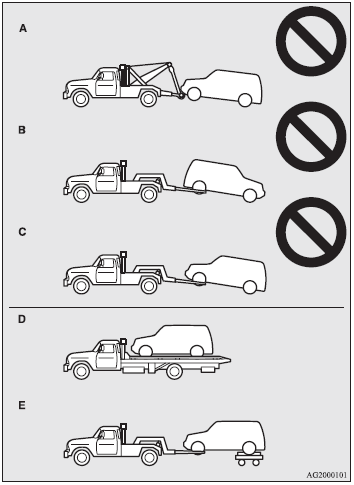
If you need to tow your vehicle, we recommend that you contact a MITSUBISHI MOTORS
Authorised Service Point or tow truck company. In the following cases, transport
the vehicle using a tow truck.
● The engine runs but the vehicle does not move, or an abnormal noise is produced.
● Inspection of the vehicle’s underside reveals that oil or some other fluid is
leaking. Only when you cannot receive a towing service from a MITSUBISHI MOTORS
Authorised Service Point or commercial tow truck service, tow your vehicle carefully
in accordance with the instructions given in “Emergency towing” in this part. The
regulations concerning towing may differ from country to country. It is recommended
that you obey the regulations of the area where you are driving your vehicle.
Towing the vehicle by a tow truck
CAUTION:
● This vehicle must not be towed by a tow truck using sling lift type equipment
(Type A) as illustrated. Using a sling lift will damage the bumper and front end.
● Do not tow your vehicle with the front or rear wheels on the ground (Type B or
Type C) as illustrated. This could result in driving system damage or vehicle may
jump at the carriage. If you tow the vehicle, use Type D or E equipment.
● The vehicle cannot be towed with only the front or rear tyres on the ground even
if it is in “2WD” drive mode.
Emergency towing
If towing service is not available in an emergency, your vehicle may be temporarily towed by a cable or chain secured to the towing hook. In case of your vehicle is to be towed another vehicle or your vehicle tows another vehicle, pay careful attention to the following points.
If your vehicle is to be towed by another vehicle
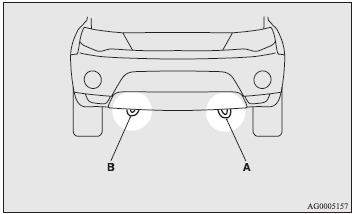
1. The front towing hook (A) is located as shown in illustration. Secure the tow rope to the front towing hook.
NOTE:
● Do not use the tie-down hook (B) for towing. This hook is provided only for the
purpose of transporting the vehicle itself. Using any part other than the designated
towing hook (A) could result in damage to vehicle body.
● Using a wire rope or metal chain can result in damage to the vehicle body. It
is best to use a non-metallic rope. If you use a wire rope or metal chain, wrap
it with cloth at any point where it touches the vehicle body.
● Use care that the tow rope is kept as horizontal as possible. An angled tow rope
can damage the vehicle body.
● Never attempt to tow out a ditched vehicle, because the tow rope cannot be kept
horizontal.
2. Keep the engine running. If the engine is not running, turn the ignition key to the “ACC” or “ON” position to unlock the steering wheel.
WARNING:
● When the engine is not running, the brake booster and power steering pump do not
operate. This means higher brake depression force and higher steering effort are
required. Therefore, vehicle operation is more difficult than usual.
CAUTION:
● Do not leave the ignition switch in the “LOCK” position and do not remove the
ignition key from the ignition switch while driving. The steering wheel will lock,
causing loss of control.
3. Shift the gearshift lever into the “N” (Neutral) position. 4. Turn on the hazard warning lamps if required by law. (Follow the local driving laws and regulations) 5. During towing make sure that close contact is maintained between the drivers of both vehicles, and that the vehicles travel at low speed.
WARNING:
● Avoid sudden braking, acceleration and steering wheel movements; such driving
operation could cause damage to the towing hook or towing rope. People in the vicinity
could be injured as a result.
● When going down a long slope, the brakes may overheat, reducing effectiveness.
Have your vehicle transport by a tow truck.
If your vehicle tows another vehicle
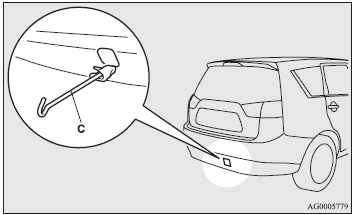
1. Take out the towing hook, wheel nut wrench and jack bar. Refer to “Tools and jack” on page 6-9. 2. Cover the end of the jack bar (C) with cloth and use it to remove the lid from the rear bumper.
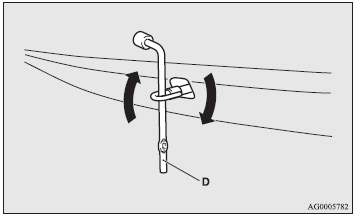
3. Use the wheel nut wrench (D) to firmly attach the towing hook.
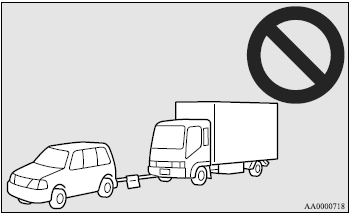
4. Always attach the towing rope to the towing hook. Otherwise, the instructions are the same as for “When being towed by another vehicle”. 5. When finished towing, remove the towing hook, and stow it in the specified location. Refer to “Tools and jack” on page 6-9. When installing the bumper lid, align the hook with the cut out area on the vehicle, and firmly insert.
NOTE:
● Do not tow a vehicle heavier than your own vehicle.
 How to change a tyre
How to change a tyre
Before changing a tyre, first stop your vehicle in a safe, flat location. 1.
Park the vehicle on level and stable ground, free of loose pebbles, etc.. 2. Set
the parking brake firmly. 3. Turn the ...
 Operation under adverse driving conditions
Operation under adverse driving conditions
On a flooded road
● Avoid flooded roads. Water could enter the brake discs, resulting in temporarily
ineffective brakes. In such cases, lightly depress the brake pedal to see if the
brake ...
See also:
Audio System Lighting
You can use the instrument panel
brightness control knob to adjust the
illumination of the audio system. The audio system
illuminates when the parking lights
are on, even if the radio is turne ...
Unfastening the seatbelt
Unfastening the seatbelt
Push the button on the buckle.
Before closing the door, make sure that
the belts are retracted properly to avoid
catching the belt webbing in the door. ...
Problems with the engine
Problem
The engine does not start. The starter motor can be heard.
Possible causes/consequences and Solutions
There is a malfunction in the engine electronics.
There is a malfunction in the fu ...
